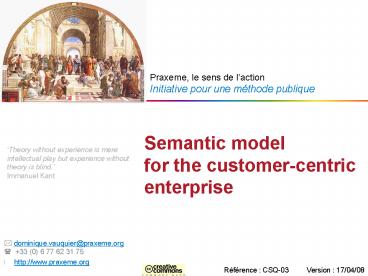Semantic model for the customercentric enterprise
1 / 24
Title:
Semantic model for the customercentric enterprise
Description:
Version : 17/04/08. R f rence : CSQ-03. Praxeme, le sens de l'action ... Immanuel Kant. Presentation goal. Objective. Topics. Modelling. Semantics. Data. Innovation ... –
Number of Views:120
Avg rating:3.0/5.0
Title: Semantic model for the customercentric enterprise
1
Semantic modelfor the customer-centric enterprise
Theory without experience is mere intellectual
play but experience without theory is
blind. Immanuel Kant
2
Presentation goal
- Objective
- Topics
- Modelling
- Semantics
- Data
- Innovation
Make sensible the change stakesimplied in the
customer centricityand the semantic approach
Duration 1h
Protection des documents
3
Content
- Introduction
- Business perspective
- Semantic modelling
- By-products and usage
4
Introduction
1
- Semantic modelling in a snapshot
- Positioning against
- Legacy system
- Business demand
- New architectures
5
The Semantic ModelAn IS response to business
transversal needs
Isolated usages of Data
- The semantic model to structure the IS and to
design services - IS Services designedfrom a business perspective
6
Business perspective
2
- Work in progress with Group Marketing department
- MKT Managers expressed their needs regarding IT
- Business orientations
- General needs in terms of IT
- Impact on IS architecture
7
Business orientations
- Customer centricity
- A change of focus, a change of culture
- With huge impact on IS systems
- Need for a single customer view
- Behavioural information
- Multi-access and Internet
- Require to make transparent the access type
- Stringent compliance to a stratified architecture
- Seamless chain of activity
- Integration of partners systems
- Better reactivity
- Business intelligence reporting on a shorter
basis - Time to market in developing new products
8
Semantic modelling
3
- Definition
- Application
- Revealing the interpretation of
customer-centricity - Examples
9
Definition of Semantic Modelling
Applied to the semantic aspect
Modelling techniques
- Semantic modelling aims at describing the
business basics, in a formal way
Omitting organisational technicaldetails or
contingencies
A runnable model
10
An upper level in separation of concerns
Knowledgebasics, objectsconcepts
Activityprocesses, use-cases
Software,tools
Hardware, infrastructure
11
What does customer centricity mean ?
- 2nd interpretation
- CC training to see things the same way the
customer does
- 1st interpretation
- CC considering the customer extracting
knowledge from information
12
Consequences on CC-model
- 1st interpretation
- Classical data modelling
- 2nd interpretation
- Radical semantic modelling
13
A matter of structure and agility
14
Content of the deliverables
- Pre-modelling
- Terminology
- Thesaurus
- Model
- Documented classes
- State machines
- Rules
- Comments
- Objects domains
- Modelling decisions
15
By-products and usage
4
- Position in the activity chain
- Assistance with selecting tools (conceptual
compliance)
16
Positioning of semantic modelling
- The starting point should not be the IT systems
- A semantic model expresses, in a formal way, the
business knowledge - It addresses questions such as
- What is a client? (sic)
- Which information, actions and transformations
does a concept convey? - How do concepts and objects naturally relate to
one another? - A semantic model stands above organisational
specificities - It provides the optimum conditions for
convergence
17
Business the good description
- Approach by activities
- Classical approach
- Flawed with local variation
- Functional hierarchical breakdown structure
- Semantic modelling
- Additional approach
- Move to genericity
- New solution to cope with complexity
Semantic aspect
Objects
Business objects, real objects (InformationTransf
ormationAction)
Refers to
Pragmatic aspect
Activities
Actors organisational entitiesProcess
use-cases
18
Software the good structure
- Determine the software structure from the
business description - Applying MDA standard
- Independently from technical choices
- Technical Target free
- Long term
Semantic aspect
Logical aspect
Objects
Logical services aggregates (logical machines)
Derives
Business objects, real objects (InformationTransf
ormationAction)
Pragmatic aspect
Activities
Derives
Actors organisational entitiesProcess
use-cases
SOA
19
Logical architecture the change
Caricature of an architecturebased upon
functional approach
Outlined logical architectureaccording to
Praxeme method
FD
FD
FD
FD
OD
OD
OD
BO
OD
OD
BO
FD
FD
FD
FD
Logical blocks take in charge functional
domains Which structure the pragmatic model It
stems from that important dependencies
orredundancies since same business objects are
usedinside many functional domains
- Several logical blocks match with the objects
domainsfrom semantic model. - Dependencies obey topological constraints
- Between strata (Business Core, Organization,
Interaction) - Coupling reducing,
- No dependency between FD, unless special cases,
- etc.
FD functional domain BO business object OD
objects domain
20
Benefits of semantic models
- From this core business representation we can
- Derive other models
- Guide processes IT design
Data modelling
- SOA
- services
- flows
Semantic model
Logical aspect
Pragmatic aspect
Processes innovation
21
Connection between objects and activities
- Broad view
- Detailed view
22
Business stakes
- A semantic model, within its limit, allows
- To capture the business knowledge
- In formal terms accurate and operational
- In natural categories
- To provide insight into the real world
- To help change focus ? e.g. customer centric
rather than internal focus - To guarantee interoperability at business IT
levels - By deriving a good pivot language
- To free offer development from existing patterns
- Its easier to think of differentiation
considering business objects rather than the
organisational processes
23
IT stakes
- This approach contributes to restructuring IT
systems - By introducing objects domains
- By shifting from functional to object approach
- It isolates a core system
- Easily sharable
- Independent from organisational specificities
- It paves the way for services design (SOA)
- The services derive from operations of semantic
classes - They populate the core layer
- They are highly reusable
24
Conclusion
- For further information
- Praxeme Institute, non-profit association
- www.praxeme.org
- In order to receive information, you can register
- http//groups.google.com/group/Praxeme-Annonces
Meaning in action
Help us to help you!































